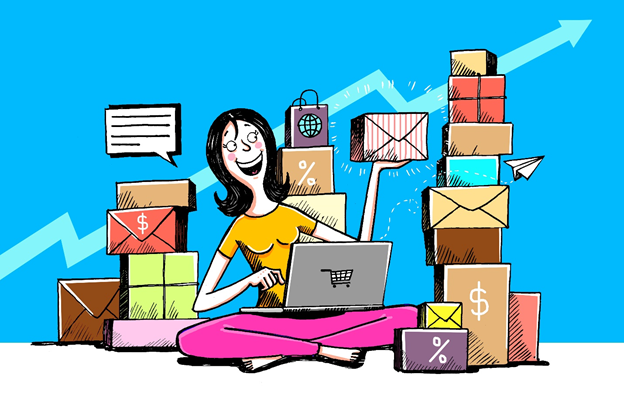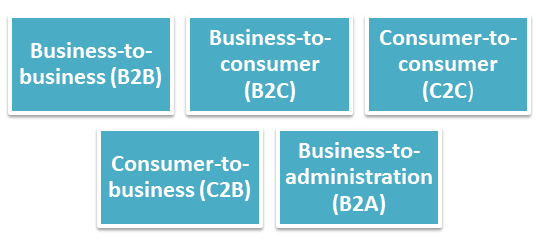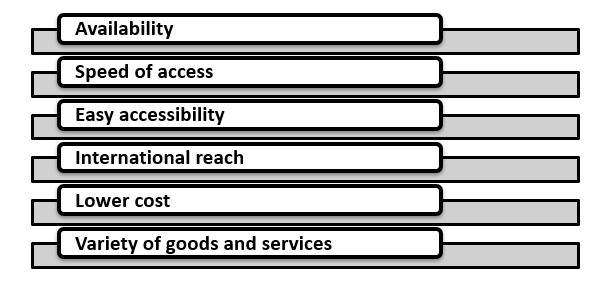Definition
Related Definitions
E-commerce
What is an E-commerce?
E-commerce stands for electronic commerce, which refers to the process of buying and selling product and services over electronic network such as internet. E-commerce is the business model through which individuals and firms buy and sell the things (products& services) over internet through online platforms.
Summary
- E-commerce stands for electronic commerce, refers to the process of buying and selling product and services over electronic network such as internet.
- E-commerce provides an electronic channel for exchange of goods and services via smartphones, computers, and tablets.
- E-commerce establishes a wider market presence to business by providing them an efficient and cheaper distribution channels for their goods and services.
Source: Copyright © 2021 Kalkine Media
Understanding E-commerce
E-commerce provides an electronic channel for exchange of goods and services via smartphones, computers, and tablets. It is kind of digital version of mail-order catalog shopping. Usually, all kind of goods and services are available over electronic commerce such as food items, grocery, books, electronic items, music, plain & train tickets, investment services (stock investing), online banking and etc.

Copyright © 2021 Kalkine Media
E-commerce establishes a wider market presence to business by providing them an efficient and cheaper distribution channels for their goods and services. Electronic commerce is operated by the internet, where buyer can place an order for goods and services via devices like mobiles, computers. E-commerce is a process of exchange of products and services via internet and includes the transfer of data (catalog of products and services) and money to complete the sales.
Frequently Asked Questions (FAQs)
What are the types of E-commerce?
Types of E-commerce may include the following:

Source: Copyright © 2021 Kalkine Media
- Business-to-business (B2B):
Business-to-business (B2B) refers to the exchange of goods and services between the businesses via internet. In this type of e-commerce exchange of goods and services conduct between two businesses through electronic platform such as a manufacture, a wholesaler, and retailer. In B2B, one business sells its goods and services to another business without any involvement of consumer.
- Business-to-consumer (B2C)
Business-to-consumer (B2C) is one of the most popular and common type of e-commerce under which a business selling its goods and services directly to the consumer. A consumer can directly buys goods and services from the business through online stores such as Amazon, Flipkart, Just Dial, and others.
- Consumer-to-consumer (C2C)
Consumer-to-consumer (C2C) refers to the type of e-commerce under which one consumer buy and sell products and services with another consumer via online platforms, which includes online auctions and classified advertisements. Generally, these transactions are conducted by a third party who is the provider of the online platform on which exchanges are carried out.
- Consumer-to-business (C2B)
Consumer-to-business (C2B) refers to the type of e-commerce in which consumers sells their products and services to the companies through online bidding on purchase. It includes photographers, freelancers, consultants, and others. Consumer-to-business (C2B) is just opposite of B2C.
- Business-to-administration (B2A)
Under business-to-administration (B2A) transactions are done between companies and public administration or government bodies via online method. There are various branches of government that are dependent on e-services or products somehow. For example, services of registration, legal documents, social security, fiscals and employment.
What are the advantages of e-Commerce?
Advantages of e-Commerce are:

Source: Copyright © 2021 Kalkine Media
- Availability: One of the biggest advantages of e-commerce is availability. e-Commerce gives access to a wide market of goods and services through online platforms. E-commerce offers 24x7 hours availability of products and services via internet. There are several websites for various products which a consumer can consider before buying anything. Consumers have a wide range of products of different brands.
- Speed of access. Through e-Commerce sites consumers can quickly access to desirable products and services. In case of offline (physical store), consumers have to wait if a store is crowded. In online deals, transactions are done within a few minutes by adding the product in cart and just with few clicks.
- Easy accessibility. Through e-Commerce customer have easy access to online sites via smartphone, computer, and tablets. Customers have to go for buying and finding a product in various stores physically that will take so much time. Through e-commerce customers can avoid this kind of trouble and can buy goods and services immediately via online.
- International reach. Through e-Commerce consumer can easily purchase any product of a foreign country that is available in the web.
- Lower cost. e-Commerce offers online platform for buying and selling goods and services that reduce the cost of a business in various ways including associated cost of physical store such as inventory, electricity, rent, and others.
- Variety of goods and services. e-Commerce sites have a wide range of product of services depending on the choices of an individual. A consumer has so many options in from of them which are not possible in physical store.
What are the disadvantages of E-commerce?
Following are some of the disadvantages of e-Commerce:

Source: Copyright © 2021 Kalkine Media
- Not being able to touch. One of the biggest disadvantages of e-commerce is that a consumer is not able to touch or see products. That is the reason a consumer thick twice before purchasing from online sites. They have a fear of receiving a wrong or faulty product, which are not as per customers’ expectations.
- Wait time. A consumer has to wait even after the purchasing of good. In physical purchasing, if consumer like something he/she purchases and take it home with them. But in case of online shopping, a consumer has to wat for the delivery of the product that usually takes a few days.
- There are high chances of frauds and misuse of a consumer’s information while using e-Commerce sites. There is a risk that hackers who usually create authentic-looking websites and may hack the site of a seller that allow him to possess credit card information of other customers.
